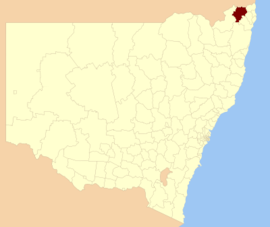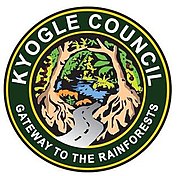Kyogle Council is a local government area in the Northern Rivers region of New South Wales, Australia.
| Kyogle Council New South Wales | |||||||||||||||
|---|---|---|---|---|---|---|---|---|---|---|---|---|---|---|---|
 Location in New South Wales | |||||||||||||||
| Population |
| ||||||||||||||
| • Density | 2.4909/km2 (6.452/sq mi) | ||||||||||||||
| Area | 3,589 km2 (1,385.7 sq mi)[3] | ||||||||||||||
| Mayor | Kylie Thomas, (Independent) | ||||||||||||||
| Council seat | Kyogle | ||||||||||||||
| Region | Northern Rivers | ||||||||||||||
| State electorate(s) | Lismore[4] | ||||||||||||||
| Federal division(s) | Page | ||||||||||||||
 | |||||||||||||||
| Website | Kyogle Council | ||||||||||||||
| |||||||||||||||
The council services an area of 3,589 square kilometres (1,386 sq mi) and is located adjacent to the Summerland Way and the North Coast railway line, within two hours drive from Brisbane and one hour from the Queensland Gold Coast and the NSW coastal communities of Byron Bay, Ballina and Tweed Heads. Kyogle Council comprises a large and diverse region with natural attributes, including the Border Ranges National Park and other world heritage listed areas, and cultural features.[5]
The mayor of Kyogle Council is Clr. Kylie Thomas.
In 2015, Kyogle Council was deemed 'not fit for future' by the New South Wales government's Independent Pricing and Regulatory Tribunal and urged to merge with a nearby council.,[6] however the government backflipped later in 2015 and allowed the council to continue in its current form.[7]
Towns and localities edit
- Kyogle
- Bonalbo
- Tabulam
- Woodenbong
- Afterlee
- Barkers Vale
- Bottle Creek
- Capeen
- Cawongla
- Collins Creek
- Cougal
- Ettrick
- Findon Creek
- Green Pigeon
- Grevillia
- Homeleigh
- Horseshoe Creek
- Iron Pot Creek
- Loadstone
- Lynchs Creek
- Mallanganee
- Mount Lion
- Mummulgum
- Old Bonalbo
- Rukenvale
- Terrace Creek
- The Risk
- Theresa Creek
- Tooloom
- Toonumbar
- Tunglebung
- Upper Horseshoe Creek
- Wadeville
- Wiangaree
- Woolners Arm
Heritage listings edit
The Kyogle Council has a number of heritage-listed sites, including:
- High Conservation Value Old Growth forest[8]
- Cougal, 871.00 km Border Loop, North Coast railway: Cougal Spiral[9]
Demographics edit
At the 2011 census, there were 9,228 people in the Kyogle local government area, of these 50.3 per cent were male and 49.7 per cent were female. Aboriginal and Torres Strait Islander people made up 5.3 per cent of the population, which was significantly higher than the national and state averages of 2.5 per cent. The median age of people in the Kyogle Council area was 45 years, which was significantly higher than the national median of 37 years. Children aged 0 – 14 years made up 19.1 per cent of the population and people aged 65 years and over made up 17.3 per cent of the population. Of people in the area aged 15 years and over, 46.6 per cent were married and 15.1 per cent were either divorced or separated.[10]
Population growth in the Kyogle Council area between the 2001 census and the 2006 census was 1.06 per cent; and in the subsequent five years to the 2011 census, the population declined 0.3 per cent. When compared with total population growth of Australia for the same periods, being 5.78 per cent and 8.32 per cent respectively, population growth in the Kyogle local government area was significantly lower than the national average.[11][12] The median weekly income for residents within the Kyogle Council area was significantly lower than the national average.[10]
At the 2011 census, the proportion of residents in the Kyogle local government area who stated their ancestry as Australian or Anglo-Saxon exceeded 85 per cent of all residents (national average was 65.2 per cent). In excess of 23 per cent of all residents in the Kyogle Council at the 2011 census nominated no religious affiliation, compared to the national average of 22.3 per cent. Meanwhile, affiliation with Christianity was 55 per cent, which was slightly higher than the national average of 50.2 per cent. As at the census date, compared to the national average, households in the Kyogle local government area had a significantly lower than average proportion (3.5 per cent) where two or more languages are spoken (national average was 20.4 per cent); and a significantly higher proportion (92.9 per cent) where English only was spoken at home (national average was 76.8 per cent).[10]
| Selected historical census data for the Kyogle Council local government area | |||||
|---|---|---|---|---|---|
| Census year | 2001[11] | 2006[12] | 2011[10] | ||
| Population | Estimated residents on Census night | 9,159 | 9,256 | 9,228 | |
| LGA rank in terms of size within New South Wales | 92 | ||||
| % of New South Wales population | 0.13% | ||||
| % of Australian population | 0.05% | 0.05% | 0.04% | ||
| Cultural and language diversity | |||||
| Ancestry, top responses |
Australian | 32.3% | |||
| English | 31.6% | ||||
| Irish | 10.2% | ||||
| Scottish | 7.7% | ||||
| German | 3.4% | ||||
| Language, top responses (other than English) |
German | 0.6% | 0.6% | 0.5% | |
| Italian | 0.2% | 0.3% | 0.2% | ||
| Swedish | n/c | 0.1% | 0.2% | ||
| French | 0.1% | 0.1% | 0.2% | ||
| Telugu | n/c | n/c | 0.1% | ||
| Religious affiliation | |||||
| Religious affiliation, top responses |
No Religion | 15.1% | 18.4% | 23.4% | |
| Anglican | 23.9% | 23.4% | 21.4% | ||
| Catholic | 21.0% | 20.7% | 19.6% | ||
| Uniting Church | 11.0% | 9.3% | 8.0% | ||
| Presbyterian and Reformed | 7.0% | 6.1% | 6.0% | ||
| Median weekly incomes | |||||
| Personal income | Median weekly personal income | A$305 | A$376 | ||
| % of Australian median income | 65.5% | 65.2% | |||
| Family income | Median weekly family income | A$705 | A$883 | ||
| % of Australian median income | 60.2% | 59.66% | |||
| Household income | Median weekly household income | A$599 | A$714 | ||
| % of Australian median income | 58.3% | 57.9% | |||
References edit
- ^ Australian Bureau of Statistics (27 June 2017). "Kyogle (A)". 2016 Census QuickStats. Retrieved 8 December 2017.
- ^ "3218.0 – Regional Population Growth, Australia, 2017–18". Australian Bureau of Statistics. 27 March 2019. Retrieved 27 March 2019. Estimated resident population (ERP) at 30 June 2018.
- ^ "Kyogle Council". Department of Local Government. Retrieved 19 November 2006.
- ^ "Lismore Electoral District". New South Wales Electoral Commission. Retrieved 19 November 2006.[permanent dead link]
- ^ "Annual Report 2014/2015" (PDF). Kyogle Council. 9 November 2015. p. 4. Retrieved 28 May 2016.
- ^ "Tweed, Kyogle and Clarence Valley not 'fit for the future'". ABC News. 20 October 2015.
- ^ "Kyogle Council avoids forced amalgamation". ABC News. 18 December 2015.
- ^ "High Conservation Value Old Growth forest". New South Wales State Heritage Register. Department of Planning & Environment. H01487. Retrieved 18 May 2018. Text is licensed by State of New South Wales (Department of Planning and Environment) under CC-BY 4.0 licence.
- ^ "Border Loop railway formation and landscape". New South Wales State Heritage Register. Department of Planning & Environment. H01027. Retrieved 18 May 2018. Text is licensed by State of New South Wales (Department of Planning and Environment) under CC-BY 4.0 licence.
- ^ a b c d Australian Bureau of Statistics (31 October 2012). "Kyogle". 2011 Census QuickStats. Retrieved 28 May 2016.
- ^ a b Australian Bureau of Statistics (9 March 2006). "Kyogle (A)". 2001 Census QuickStats. Retrieved 22 May 2016.
- ^ a b Australian Bureau of Statistics (25 October 2007). "Community Profile Series: Kyogle (A) (Local Government Area)". 2006 Census of Population and Housing. Retrieved 27 October 2010.
External links edit
Media related to Kyogle Council at Wikimedia Commons